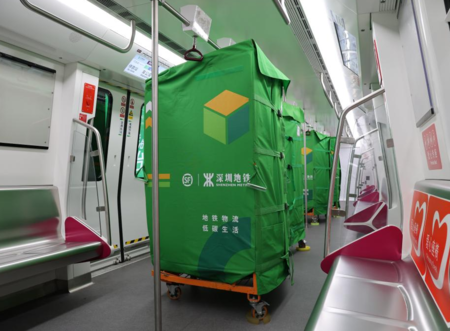During the day, Shenzhen’s stations look, in some ways, like those of any big city: full of movement, loudspeakers and announcements marking the passage of trains. But when traffic eases, something changes. In the same space where a few hours ago there were crowds, autonomous vehicles and small robots appear that move with precision, transporting packages from one point to another. There is no spectacle or artifice, just a different use of a familiar environment. The metro network, designed for travelers, is also beginning to serve urban logistics at a time when every minute and every square meter counts.
The idea of taking advantage of the subway to move goods does not arise on a whim. In Shenzhen, as in many large Chinese cities, surface traffic has become an obstacle to daily logistics. Delivery companies deal with extreme urban density and the constant growth of e-commerce, which forces them to deliver faster and with increasingly tight margins. Using trains outside of peak hours allows us to alleviate this pressure and reduce costs, while at the same time making use of infrastructure that usually remains underused for much of the day.
When travelers leave, robots stay
According to the Xinhua agency, one of the officially documented pilots takes place on line 11 of the Shenzhen metro. Every night in Futian District, SF Express staff sort and pack packages, which are then loaded into metal cages. These cages are transported by means of a autonomous shuttle vehicle to the platform, where they are destined for the sixth coach of the train, enabled as a logistics car during off-peak hours. In less than thirty minutes, the goods cross the most congested stretch of the city and arrive at the Bihaiwan area, near the airport, where they continue their journey to the distribution center.
The aforementioned operation is supported by a fleet of robovans. Nikkei Asia explains that these are small vehicles capable of moving autonomously along predetermined routes, where they transfer packages from a storage center to the subway loading area. Each one can transport up to 500 kilos and has a useful space of about 3 cubic meters.

Another official test takes place on subway line 2, at Wanxia station, where delivery robots are able to board the train by themselves to deliver goods to stores 7-Eleven inside the station. The system, described by the Guangdong Department of Transportation, combines autonomous route planning, laser sensors and a control system that allows it to move safely between passengers. The project, promoted by Shenzhen Metro Group, Vanke and Wanwei Logistics, remains in the testing phase and seeks to verify whether it can be applied on a larger scale in the city’s underground commercial network.


The Chinese industrial ecosystem is one of the reasons why these types of projects are advancing so quickly. The aforementioned newspaper highlights that strong competition between national manufacturers has made key components such as LiDAR sensors cheaper and has driven the development of more efficient batteries and specific chips for autonomous driving. On this basis, production costs are significantly reduced. A robovan is already between 20 and 30% cheaper than a traditional commercial vehicle, and the difference increases by eliminating cabin space and the cost of the driver.


The development of these initiatives is not without difficulties. Autonomous vehicles still depend on human supervision at various stagesespecially in the loading and unloading of goods. Its speed inside the stations is reduced to guarantee the safety of passengers, and that limits the operational pace.

For now, operations remain limited and are far from mass application. Even so, they reflect a clear trend: the attempt to optimize each section of urban space, even the underground. Shenzhen functions as a laboratory for a model that seeks efficiency without altering the rhythm of the city. Ultimately, these tests speak less about technology than about management: about how a metro network can serve two different purposes while remaining, above all, a public service.
Images | Guangdong Department of Transportation (1, 2, 3, 4, 5) | Shenzhen Government (1)
In WorldOfSoftware | Many Spanish ports have become luxury resorts for the rich: owning a pleasure boat is increasingly difficult











